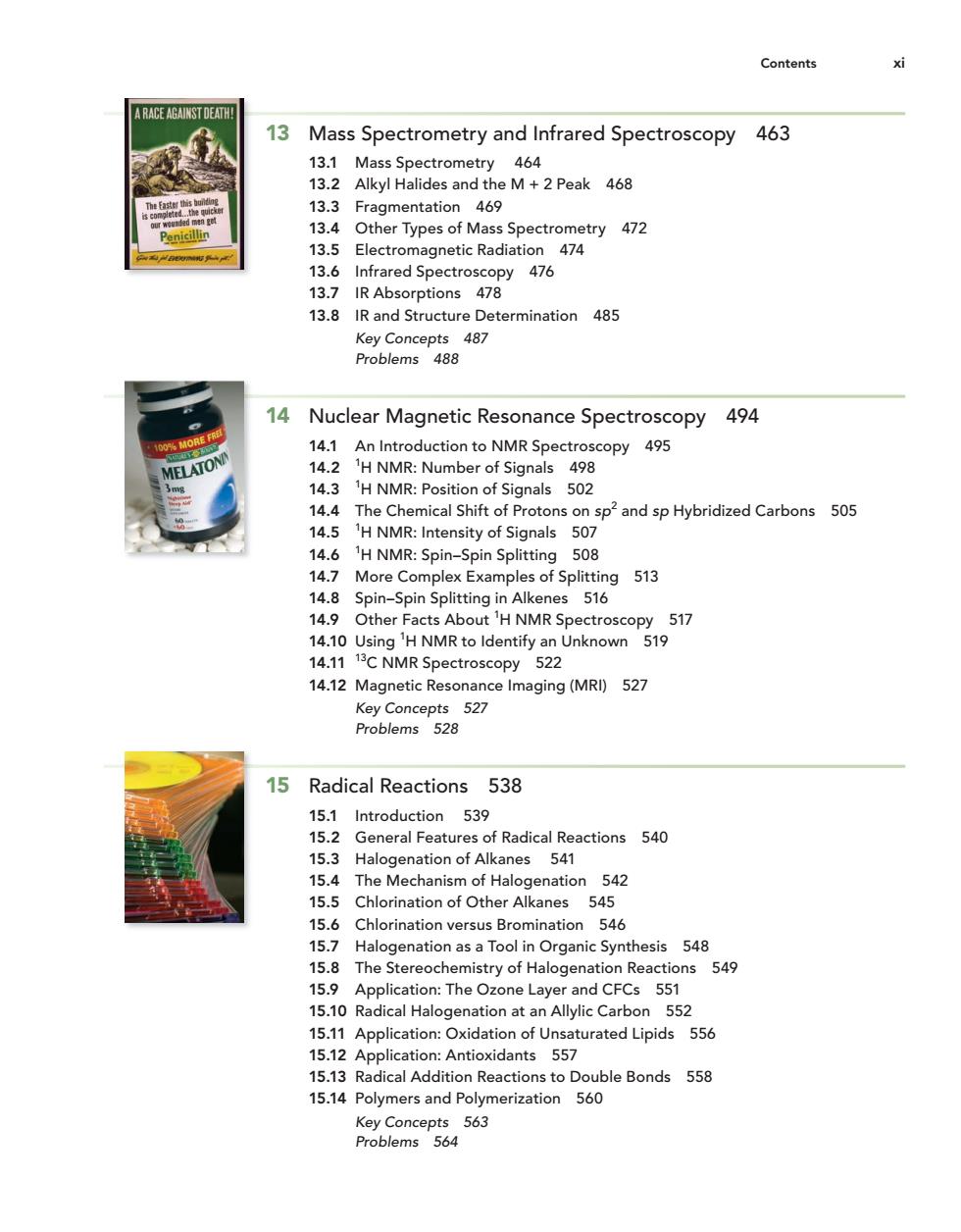正在加载图片...

Contents RACE AGAINST DEATH Mass Spectrometry and Infrared Spectroscopy 463 131 Mass Spectrometry 464 13.2 Alkyl Halides and the M+2 Peak 468 13.3 Fragmentation 469 13.4 Other Types of Mass Spectrometry 472 13.5 Electromagnetic Radiation 474 13.6 Infrared Spectroscopy 476 13.7 IR Absorptions 478 13.8 IR and Structure Determination 485 487 Nuclear Magnetic Resonance Spectroscopy 494 14.1 An Introduction to NMR Spectroscopy 495 14.2 H NMR:Number of Signals 498 H NMR:Position of Signals 502 The Chemical Shift of Protons on sp2 and sp Hybridized Carbons 505 14.5 H NMR:Intensity of Signals 507 14.6 H NMR:Spin-Spin Splitting 508 14.7 More Complex Examples of Splitting 513 14.8 Spin-Spin Splitting in Alkene 516 14.9 Other Facts Abo t'H NMR Spectroscopy 517 14.10 Using 'H NMR to ldentify n Unknown 19 14.11 13C NMR Spectroscopy 52 14.12 Magnetic Resonar nce Imaging(MRI) 527 Key Concepts 527 Problems 528 不 Radical Reactions 538 15.1 Introduction 539 15.2 General Features of Radical Reactions 540 15.3 Halogenation of Alkanes 541 15.4 The Mechanism of Halo enation 542 15.5 Chlorination of Other Alka 545 546 Organic Synth 548 mistry of Halogenation React ons 549 Application:The Ozone Layer and CFCs 557 15.10 Radical Halogenation at an Allylic Carbon 552 15.11 Application:Oxidation of Unsaturated Lipids 556 15.12 Application:Antioxidants 557 15.13 Radical Addition Reactions to Double Bonds 558 15.14 Polymers and Polymerization 560 ConContents xi 13 Mass Spectrometry and Infrared Spectroscopy 463 13.1 Mass Spectrometry 464 13.2 Alkyl Halides and the M + 2 Peak 468 13.3 Fragmentation 469 13.4 Other Types of Mass Spectrometry 472 13.5 Electromagnetic Radiation 474 13.6 Infrared Spectroscopy 476 13.7 IR Absorptions 478 13.8 IR and Structure Determination 485 Key Concepts 487 Problems 488 14 Nuclear Magnetic Resonance Spectroscopy 494 14.1 An Introduction to NMR Spectroscopy 495 14.2 1 H NMR: Number of Signals 498 14.3 1 H NMR: Position of Signals 502 14.4 The Chemical Shift of Protons on sp2 and sp Hybridized Carbons 505 14.5 1 H NMR: Intensity of Signals 507 14.6 1 H NMR: Spin–Spin Splitting 508 14.7 More Complex Examples of Splitting 513 14.8 Spin–Spin Splitting in Alkenes 516 14.9 Other Facts About 1 H NMR Spectroscopy 517 14.10 Using 1 H NMR to Identify an Unknown 519 14.11 13C NMR Spectroscopy 522 14.12 Magnetic Resonance Imaging (MRI) 527 Key Concepts 527 Problems 528 15 Radical Reactions 538 15.1 Introduction 539 15.2 General Features of Radical Reactions 540 15.3 Halogenation of Alkanes 541 15.4 The Mechanism of Halogenation 542 15.5 Chlorination of Other Alkanes 545 15.6 Chlorination versus Bromination 546 15.7 Halogenation as a Tool in Organic Synthesis 548 15.8 The Stereochemistry of Halogenation Reactions 549 15.9 Application: The Ozone Layer and CFCs 551 15.10 Radical Halogenation at an Allylic Carbon 552 15.11 Application: Oxidation of Unsaturated Lipids 556 15.12 Application: Antioxidants 557 15.13 Radical Addition Reactions to Double Bonds 558 15.14 Polymers and Polymerization 560 Key Concepts 563 Problems 564 smi75625_fm_00i-xxxiv.indd xi 11/17/09 11:21:25 AM